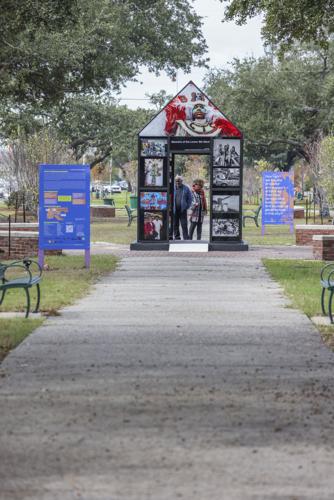Photographers Chandra McCormick and Keith Calhoun grew up in the Lower 9th Ward, went to school there, married there, established their international careers there and stayed there, even after their Flood Street studio was ruined during the catastrophic flooding that accompanied Hurricane Katrina.
As Calhoun recently said, “Some of the great photographers in the world come here, but they’re not rooted like we are.”
So, McCormick and Calhoun were the perfect choice to create a monument on the North Claiborne Avenue neutral ground, devoted to the surrounding area. Of course, as photographers, they weren’t inclined to sculpt a traditional bronze statue or marble carving; they had to conceive a public artwork that accommodated their medium.

"Memoirs of the Lower 9th Ward" by photographers Chandra McCormick and Keith Calhoun photographed on the neutral ground in the 5400 block of N. Claiborne in New Orleans, Thursday, Dec. 14, 2023. (Photo by Sophia Germer, The Times-Picayune)
A Black perspective
To that end, the couple devised a sort of green house, a steel frame structure covered with enlarged photographs of the people from the surrounding neighborhood. The photos were printed on translucent panels. Inside the small structure, the photographs glow with the penetrating sunlight like stained glass. At night, the small building shines like a gem.
McCormick said that creating an artwork in the shape of a house was symbolically important because Black home ownership in the neighborhood was higher than anyplace else in the city. At least it was until the 2005 flood laid waste to a lot of the area. She’s not sure if it’s true anymore.
McCormick and Calhoun have documented many aspects of Southern life over the past decades, from a Black perspective. They’ve photographed dock workers, sugar harvesters and Louisiana State Penitentiary at Angola farm laborers. But no subject has been more compelling than the people from their neighborhood. Some of their 9th Ward photos date back 40 years or more.

The 5400 block of N. Claiborne reflects into the side of the public art piece "Memoirs of the Lower 9th Ward" on the neutral ground in New Orleans, Thursday, Dec. 14, 2023. The structure is made of photographs printed on plexiglass that were captured over a span of 40 years by photographers Chandra McCormick and Keith Calhoun. (Photo by Sophia Germer, The Times-Picayune)
Portraits of a lifestyle
While discussing the new monument, titled “Memoirs of the Lower 9th Ward,” Calhoun pointed out a portrait of “Boogie” Bill Webb, a longshoreman and blues guitarist, who used to play music at neighborhood fish fries and could fix your lawnmower as well.
McCormick called attention to a close-up portrait of Andrew Sawyer, better known as Michael Knight, who, she said, rescued innumerable stranded flood victims and came to be called “the hero of the storm” in the 9th Ward. The panels in the walls of the house sculpture include a few images of the devastating flood aftermath, which put Sawyer’s heroics in context.
Calhoun said that one of McCormick’s photos was especially important. Above one of the doorways is her ghostly black and white photograph of a ceremony conducted by female bishops in Mother Washington’s Holy Family Church, one of the old-time Spiritual churches where one came for religion and healing. Historically, Calhoun said, the churches “were the glue in the neighborhood.”
The people are beautiful
As visitors circle and pass through the small house, they discover dozens of interlocked lives: spectacular Black masking Indians, joyous second-line paraders, a toddler being pushed along in a baby carriage, a 99-year-old woman pensively folding her hands, the late neighborhood superstar Fats Domino, and on and on.
There’s a certain six-degrees-of-separation feel to the artwork. McCormick says that everyone from the neighborhood who has visited the photo house has recognized or been acquainted with a few of the people on the walls and ceiling.
McCormick said that she and Calhoun had spent a lifetime trying to capture “people, conditions and issues,” in the changing South. She views “Memoirs of the Lower 9th Ward,” as a “tribute to our community,” which has “been through so much.” And beneath it all, she said, the message is that “the people we’re photographing are beautiful.”
“It’s what we consider the soul of the 9th Ward,” Calhoun said.

Photographers Keith Calhoun and Chandra McCormick reminisce with a friend as they look at photographs in the "Memoirs of the Lower 9th Ward" public art piece on the neutral ground in the 5400 block of N. Claiborne in New Orleans, Thursday, Dec. 14, 2023. (Photo by Sophia Germer, The Times-Picayune)
International stars in our midst
McCormick and Keith Calhoun’s incisive photography has taken them far. Their works have appeared in high-profile publications including National Geographic magazine, Art in America and Smithsonian Magazine, to name a few. And they’ve exhibited everywhere from the Brooklyn Museum to Harvard University, the New Orleans Museum of Art and the Cabildo on Jackson Square.
Perhaps their crowning glory was representing the United States in the 2015 International Venice Biennale, the world’s premier art exhibit.
“We’ve exhibited around the world,” Calhoun said, but conceiving a three-dimensional structure to display the couple’s photos was a challenge, and seeing their work blown up to large scale was something new.
Calhoun said the beauty of placing the artwork in the middle of a busy street was that people may visit it who would only rarely find their way to the city’s art museums.
“Memoirs of the Lower 9th Ward” is part of the “Artists of Public Memory Commission,” presented by the Prospect New Orleans international art exhibit. It will remain in place through June on the North Claiborne Avenue neutral ground between Andry and Flood streets.
McCormick and Calhoun’s house sculpture is the second in the series, following “Abolitionist Playground” by artist kai lumumba barrow, an installation on Norman C. Francis Parkway near Canal Street.









